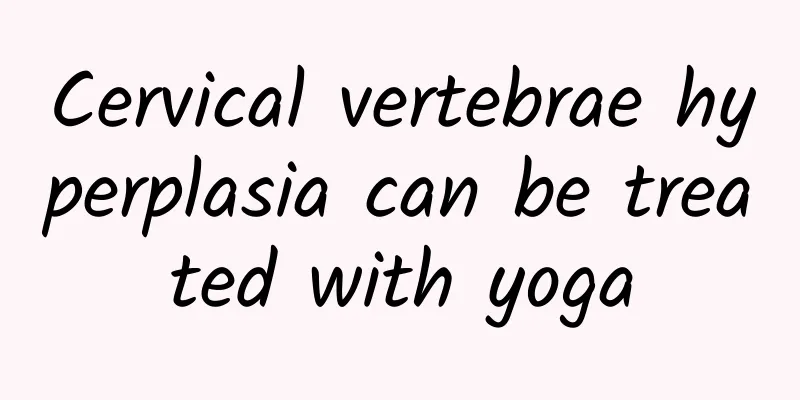Cervical vertebrae hyperplasia can be treated with yoga

|
Symptoms of cervical spondylosis can be relieved through yoga exercises, but you need to choose appropriate movements and avoid overstretching. Gentle stretching and relaxation movements in yoga can help improve blood circulation in the cervical spine and relieve pain, but they must be performed under professional guidance to avoid aggravating the condition. Cervical spondylosis is the formation of osteophytes caused by long-term uneven force or degenerative changes in the cervical bones. It is common in middle-aged and elderly people or those with long-term poor posture. 1. The main causes of cervical spondylosis include long-term poor posture, aging, and cervical degenerative changes. Long-term bowing or forward neck will increase cervical pressure and lead to bone hyperplasia. Aging reduces the water content and elasticity of the cervical intervertebral disc, making it prone to degenerative changes. Cervical spondylosis may also be caused by trauma or chronic inflammation. 2. Yoga exercises suitable for cervical spondylosis include cat-cow pose, baby pose and scoliosis. Cat-cow pose relieves cervical pressure through slow spinal flexion and extension. Baby pose relaxes neck muscles and improves blood circulation. Scoliosis gently stretches the side muscles of the neck and enhances flexibility. These movements should be performed under professional guidance to avoid overstretching or rapid twisting. 3. Yoga poses that are not suitable for cervical hyperosteogeny include headstand, shoulder stand and fish pose. These poses will increase the pressure on the cervical spine and may aggravate the condition. Headstand and shoulder stand make the cervical spine bear the weight of the whole body, which may cause pain or injury. Fish pose overly tilts the cervical spine backward, which may aggravate the symptoms of bone hyperplasia. These high-risk poses should be avoided when practicing. 4. Yoga exercises need to be combined with other treatments, such as physical therapy and drug therapy. Physical therapy includes heat, electrotherapy and traction, which can relieve pain and muscle tension. Drug therapy often uses nonsteroidal anti-inflammatory drugs and muscle relaxants to reduce inflammation and pain. Comprehensive treatment can better control symptoms and improve quality of life. 5. Pay attention to posture adjustment and neck protection in daily life. Avoid lowering your head or leaning your neck forward for a long time, and use ergonomic pillows and chairs. Move your neck regularly while working or studying, and do simple stretching exercises. Strengthen neck muscle exercises, such as neck isometric contraction exercises, to enhance cervical spine stability. Patients with cervical spondylosis can effectively relieve symptoms and improve their quality of life through scientific yoga and comprehensive treatment. However, this should be done under professional guidance to avoid aggravating the condition through improper movements. |
<<: What are the risks of minimally invasive surgery for breast cyst removal?
>>: What are the consequences of kidney stones?
Recommend
How to check for urinary tract infection in baby girls
Urinary tract infection in female babies is mainl...
What medicine is used for bone hyperplasia
Osteophyte is a common bone problem, especially a...
Early symptoms of varicose veins
An inconspicuous little problem can also grow int...
What can't you eat if you have gallstones?
Patients with gallstones should avoid high-fat, h...
Is acupuncture considered minimally invasive surgery?
Acupuncture knife is indeed a type of minimally i...
How to distinguish internal and external hemorrhoids
How to distinguish internal and external hemorrho...
What are the sequelae of nasal bone fracture reduction surgery?
The sequelae of nasal bone fracture reduction sur...
There is a piece of meat hanging under the urethra
A piece of flesh hanging down from the urethra ma...
What foods should I eat if I have breast cysts?
Patients with breast cysts can choose more foods ...
Early symptoms of pectus excavatum in infants
The early symptoms of pectus excavatum in infants...
One-year-old child with congenital heart disease ventricular septal defect
A one-year-old child diagnosed with the congenita...
What foods are good for liver cysts?
Liver cysts are a type of liver problem that many...
What are the external medicines for treating breast cysts?
The treatment of breast cysts usually needs to be...
Will a breast cyst get bigger?
Breast cysts may increase in size over time, but ...
The difference between hip impingement syndrome and femoral head necrosis
Hip impingement syndrome and femoral head necrosi...









